KEY TAKEAWAYS
- The internet contributes significantly to environmental impact, generating 3.7% of global carbon emissions, a figure comparable to the entire airline industry’s output.
- Every single webpage and mobile application action, from loading a font to streaming a video consumes energy and contributes to a digital carbon footprint.
- Third-party scripts alone can account for up to 40% of a webpage’s energy.
- By making conscious choices in code, design, and hosting platforms, developers and businesses can drastically reduce their digital emissions.
- Green hosting and sustainable web design are powerful strategies that benefit both the planet and their business success. Websites using these practices can emit up to 90% less CO₂ than their conventional counterparts.
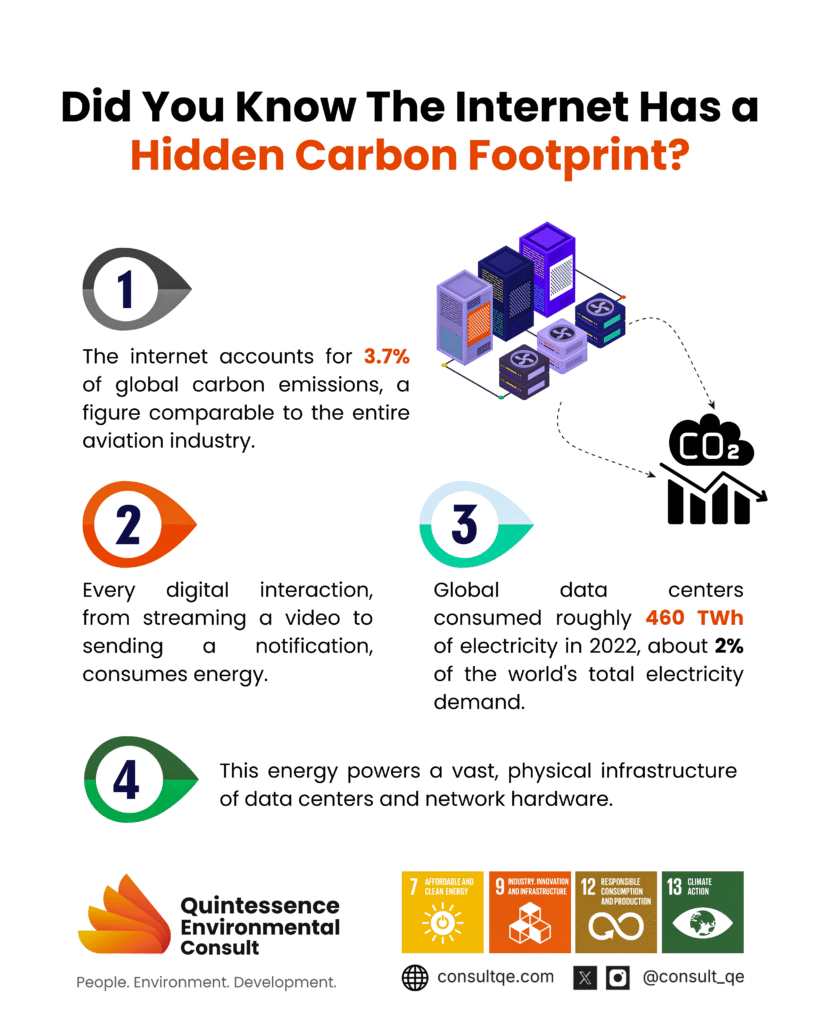
INTRODUCTION: THE HIDDEN CARBON EMISSIONS OF THE DIGITAL WORLD
The internet is not as clean as it seems. Every website you visit, every video you stream, and every notification your application sends consumes energy. With 5.56 billion internet users globally [2], the collective environmental impact of digital platforms is staggering. Digital technologies are now responsible for more greenhouse gas emissions than the entire aviation industry. Every time someone visits a website, their browser sends a request to a server, which consumes electricity, often powered by fossil fuels (coal, petroleum and natural gas). While we often think of digital technology as an ethereal and clean resource, it’s powered by a vast, physical infrastructure of servers, data centers, and network hardware that consumes massive amounts of electricity.
According to the International Energy Agency (IEA), global data centers consumed approximately 460 terawatt-hours (TWh) of electricity in 2022, which accounts for about 2% of the world’s total electricity demand. This is a staggering figure, and as our digital lives become more complex with AI, real-time video, and intricate mobile applications, this energy use is only set to increase. As mobile applications gain complexity (real-time notifications, video calls, Artificial Intelligence (AI) processing), their backend operations involve multiple layers: user device energy, network transmission, and cloud infrastructure, all of which generate carbon emissions.
The global imperative to address climate change is reshaping how brands and developers approach digital infrastructure.. How can we code and design with sustainability in mind? This blog dives deep into the carbon footprint of websites and mobile applications and what you can do to reduce it.
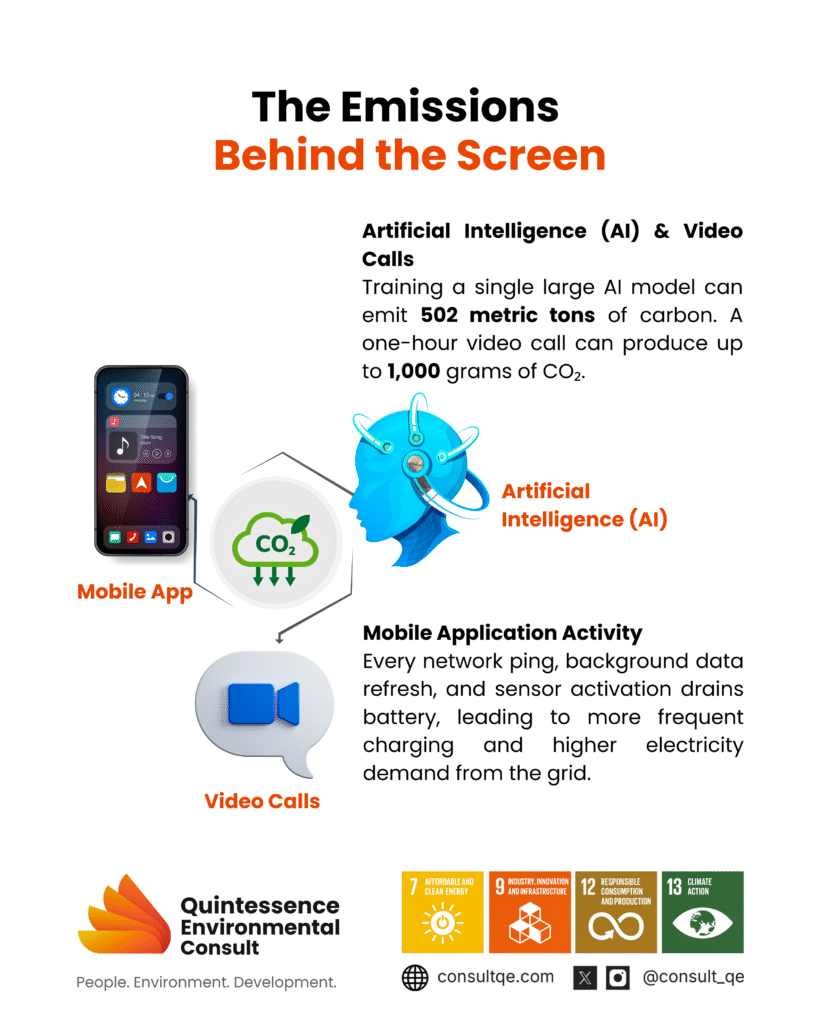
THE EMISSIONS BEHIND THE SCREEN
The digital carbon footprint is not a single, stable measurement; it’s a dynamic sum of many small but frequent emissions.
- AI and Machine Learning: Training a single large language model (LLM), such as GPT-3, is estimated to have consumed 1,287 MWh of electricity, which translates to 502 metric tons of carbon emissions, a figure equivalent to the annual emissions of a small village [6].
- Video Calls: A one-hour video call can produce between 150 and 1,000 grams of carbon dioxide, depending on the quality and hardware used. The carbon footprint of a video call can be significantly reduced by opting for an audio-only format, which cuts emissions by up to 96% [7].
- Mobile App Activity: While a single notification or data request seems negligible, the cumulative effect is substantial. Every network ping, background data refresh, and sensor activation drains battery, leading to more frequent charging and higher electricity demand from the grid. This continuous process contributes significantly to the overall carbon footprint of mobile applications, in addition to the emissions from the data centers that handle the backend operations.
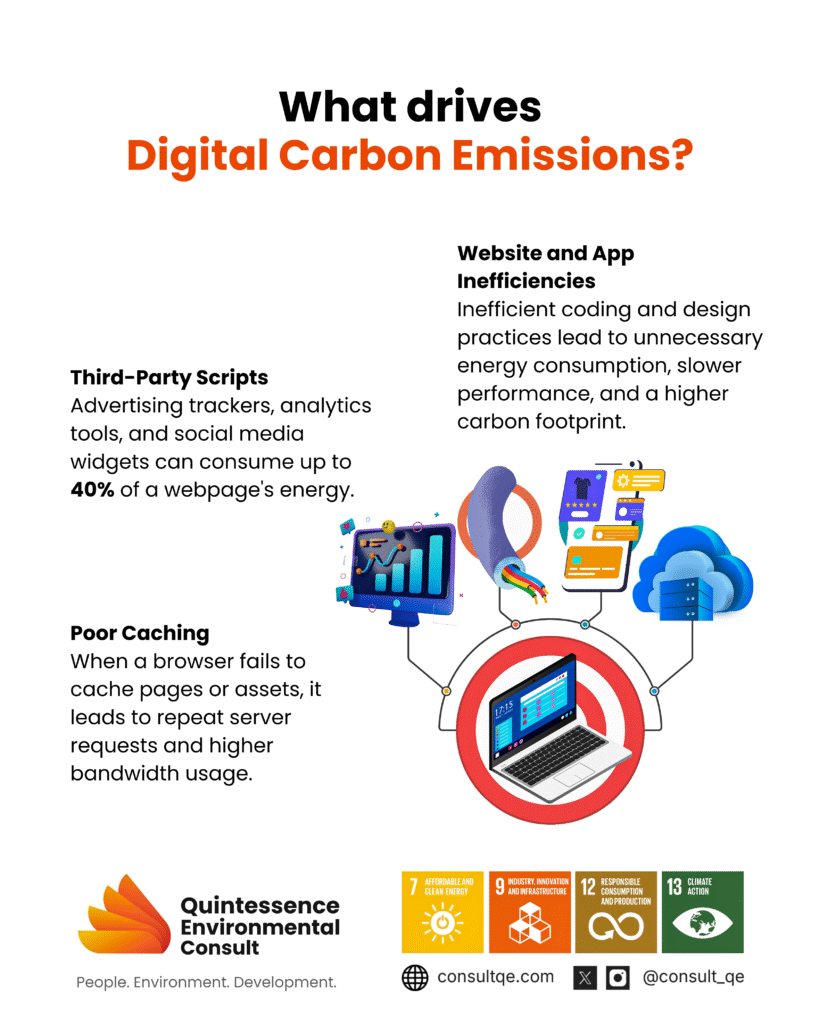
FACTORS THAT INCREASE DIGITAL CARBON FOOTPRINT
Digital carbon emissions are often the result of technical inefficiencies and design choices made during development. Common culprits include:
- Excessive Data Transfer: Unoptimized images, large video files, and uncompressed code force users’ devices and servers to work harder. Features like “infinite scroll” can also lead to the unnecessary loading of huge volumes of data.
- Third-Party Scripts: Advertising trackers, analytics tools, and social media widgets can consume up to 40% of a webpage’s total energy, creating a significant drain on resources. This figure is supported by research from sustainable web design experts, such as Wholegrain Digital [5].
- Inefficient Code: Poorly written code, data-heavy Application Programming Interface (APIs), and unnecessary animations can increase the processing power needed to render a page or run an application.
- Poor Caching: When a browser fails to cache assets like images or CSS files, it has to download them repeatedly, leading to redundant server requests and higher energy usage.
The good news? A study by the Green Web Foundation revealed that websites using green hosting and efficient code can emit up to 90% less CO₂ than their conventional counterparts [5]. This proves that with the right strategies, you can significantly reduce your digital carbon footprint.
STRATEGIES FOR A GREENER DIGITAL PRESENCE
Reducing your digital emissions isn’t just about being eco-friendly; it’s also about building a faster, more efficient, and more user-friendly product. The most effective way to reduce digital emissions is for data centers to transition to sustainable, renewable energy, as this directly lowers a company’s Scope 3 emissions from purchased cloud services. This is a crucial point for reporting, as emissions are classified differently depending on the source: a data center generating its own energy has Scope 1 emissions, while one using purchased electricity has Scope 2. A company using these services, however, must classify all of the associated emissions as its own Scope 3 emissions under the “purchased services” category. To ensure transparency, companies should utilise reporting frameworks like the Global Reporting Initiative (GRI), which provides standards for disclosing environmental impacts and enables businesses to formally track their progress in reducing their digital carbon footprint.
However, the following strategies are also how you can make a difference.
Front-End & User Interface (Ui) Optimization
The user-facing part of your application is a great place to start.
Optimize Images and Fonts: Compress images to the smallest possible file size without sacrificing quality. For icons and illustrations, use SVGs, which are lightweight and scalable. Whenever possible, use system fonts to avoid additional downloads.
Simplify Design: Adopt a minimalist design philosophy. Reduce complex animations and avoid autoplaying videos on landing pages. A dark mode option on applications and websites with OLED screens can save up to 60% of energy per user.
Build Leaner HTML: Reduce the number of nested HTML elements (Document Object Model (DOM) depth) to improve rendering performance and reduce the resources needed by the user’s device.
Back-End & Server Efficiency
Your server-side operations are a major source of energy consumption.
Optimize Your Codebase: Implement server-side rendering (SSR) to offload work from the client. Use efficient compression techniques like GZIP or Brotli to shrink the size of files sent over the network.
Refine Your Database: Optimize database queries and use connection pooling to reduce resource spikes. These simple changes can dramatically improve server efficiency.
Go Serverless: Consider using green serverless infrastructures like Vercel, Netlify, or AWS Lambda, which only consume resources when a request is made, reducing idle energy waste.
Cloud & Hosting Choices
The location and power source of your servers matter.
Use a CDN: A Content Delivery Network (CDN), like Cloudflare or Fastly, stores copies of your website’s files on servers around the world. When a user visits your website, the CDN automatically delivers the content from the server closest to them.
This makes your website load much faster for users everywhere because the information doesn’t have to travel as far.
Choose a Green Host: Switch to a hosting provider that is committed to using 100% renewable energy. Companies like Google Cloud, Microsoft Azure, and Amazon Web Service (AWS) have made strong commitments to sustainability, with some aiming to be carbon negative in the near future.
Mobile Application Efficiency
Mobile applications present unique challenges, as they rely on device energy, network transmission, and cloud infrastructure.
Reduce Network Traffic: Batch network requests and compress payloads to minimize the energy-intensive background activity.
Promote Offline-First Design: Design your application to function offline whenever possible. This reduces network pings and conserves both device battery and server resources.
Be Mindful of Tracking: Deactivate unnecessary analytics or tracking software development kit (SDKs) that constantly send data back to servers.
Monitor Battery Drain: Use built-in profiling tools on Android and iOS to monitor your application’s battery usage. High battery drain is a clear indicator of high carbon emissions.
MEASURING YOUR IMPACT
You can’t improve what you don’t measure. Several excellent tools can help you analyze your digital footprint:
- WebsiteCarbon.com [3]: A simple tool that estimates the carbon emissions of a single webpage.
- Ecograder [4]: Provides a comprehensive sustainability score and actionable tips for improvement.
- Beacon: An open-source script from The Green Web Foundation that helps you track the energy source of your hosting.
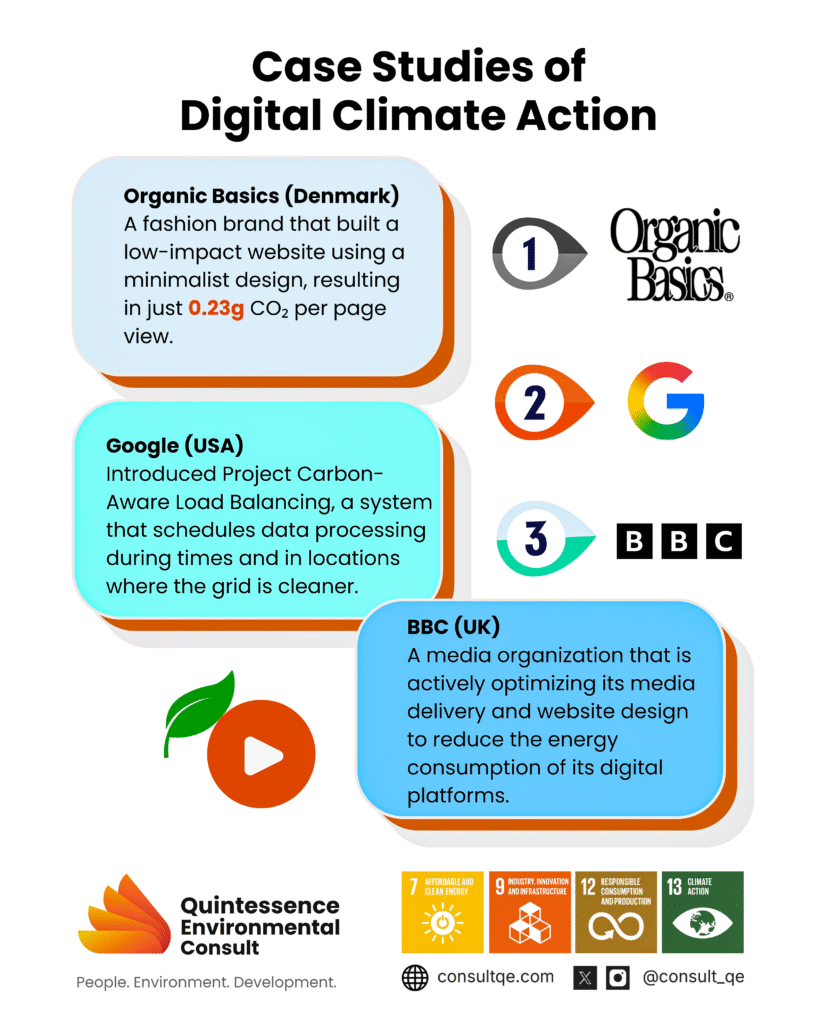
CASE STUDIES
The principles of green code are not just theoretical; they are being successfully applied by companies around the world. Here are some real-world examples of organizations that are leading the way in digital sustainability.
Organic Basics (Denmark), a fashion brand, built a low-impact website that uses a basic font, grayscale color palette, and static assets. The site avoids videos and animations, prioritizing speed and low carbon output—emitting just 0.23g CO₂ per page view.
Google (USA) introduced Project Carbon-Aware Load Balancing, a system that schedules data processing during times and in locations where the grid is cleaner.
The BBC (UK) conducted extensive research into the carbon footprint of its digital services, particularly for video streaming. By optimizing its media delivery and website design, the BBC is actively working to reduce the energy consumption of its digital platforms.
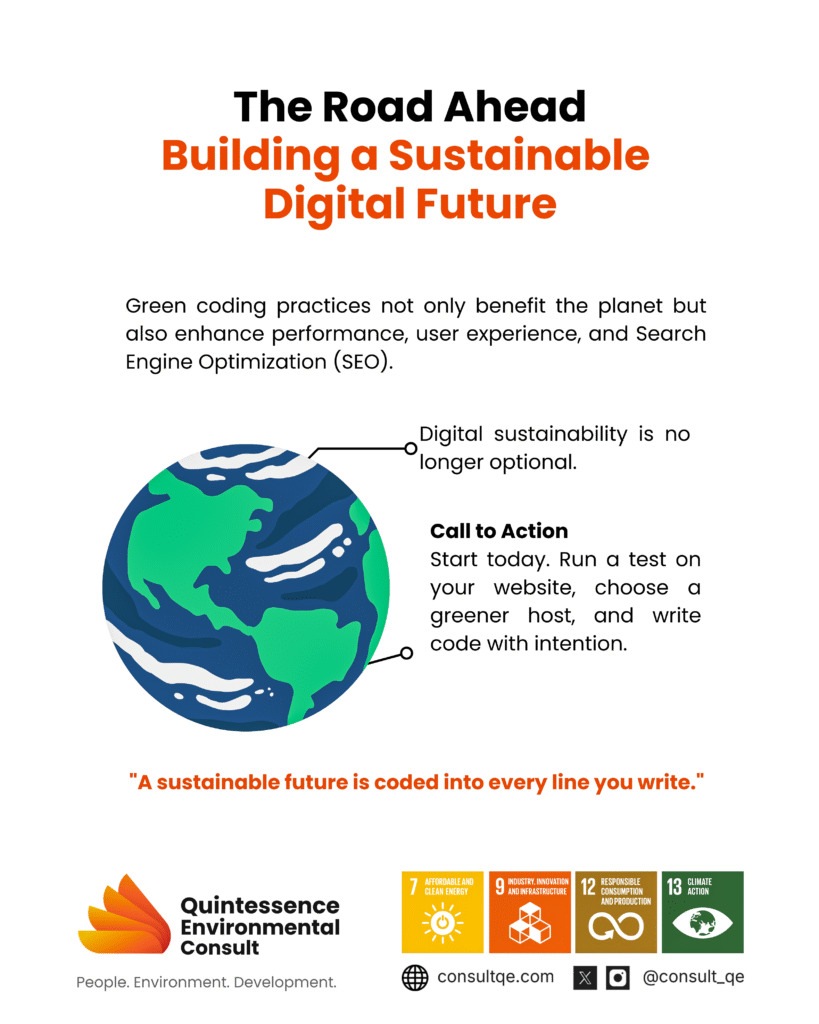
CONCLUSION: THE FUTURE IS GREEN
Digital sustainability is no longer a niche concern; it’s a critical responsibility for every brand and developer. Fortunately, the path to a greener digital presence is paved with practices that also lead to better performance, higher SEO rankings, and improved user satisfaction.
Let’s make a commitment to writing cleaner code, choosing greener hosts, and designing with intention. The future of the internet doesn’t have to be a drain on the planet. It can be a powerful force for a more sustainable world.
Are you ready to build the next generation of eco-friendly websites and apps?
- Purdue University (2021). “Turn off that camera during virtual meetings, environmental study says.” Available at: https://www.purdue.edu/newsroom/ archive/releases/2021/Q1/turn-off-that-camera- during-virtual-meetings,-environmental-study-says.html .
- Purdue University, Yale University, MIT (2021). “The environmental impacts of increased internet traffic due to COVID-19.” Available at: https://e360.yale.edu/features/artificial-intelligence-climate-energy-emissions
- Statista (2025). Global internet users. Available at: https://www.statista.com/statistics/617136/ digital-population-worldwide/
- The Shift Project (2019). “Lean ICT: Towards Digital Sobriety.” Available at: https://theshiftproject.org/en/article/lean-ict-our-new-report/
- Ecograder. Available at: https://ecograder.com/
- Website Carbon Calculator. Available at: https://www.websitecarbon.com/
- Wholegrain Digital. Available at: https://www.wholegraindigital.com
- The BBC (2025). BBC Group Annual Report and Accounts 2024/25. Available at: https://assets.publishing.service.gov.uk/,
BR>media/6876519139d0452326e28ec7/
BBC_Annual_
Report___Accounts_24_25_
final_accessible.pdf

AI and Bitcoin are both energy-intensive, but in different ways. Bitcoin mining relies on proof-of-work, consuming huge amounts of electricity often from fossil fuels while AI demands high computational power for training and running models. The real challenge isn’t just the tech, but the energy sources powering them. Transitioning to renewables is key. Unlike Bitcoin, AI also has the potential to reduce emissions by optimizing energy use, improving efficiency, and supporting climate solutions.
The future impact will depend on how quickly both industries embrace sustainable energy.